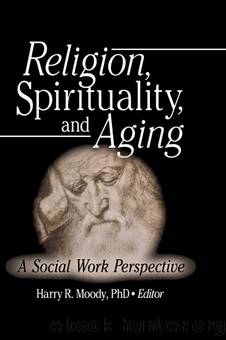Religion, Spirituality, and Aging by Moody Harry R.;

Author:Moody, Harry R.;
Language: eng
Format: epub
ISBN: 1099167
Publisher: Taylor & Francis Group
NOTES
1. In addition to semi-structured, audio-taped interviews with the caregiver, the researcher also recorded field notes of observations immediately after completing each interview. Eleven interviews occurred in the caregiverâs home or at a place chosen by the caregiver. Individual interviews with caregivers spanned one and one-half to three hours each. Follow-up interviews, lasting fifteen to sixty minutes each, were conducted for the purpose of confirming findings.
2. Purposive sampling involved the use of selection criteria. Selection criteria were developed from studies on factors that contribute to caregiver burden or stress (Pearlin, Mullan, Semple, & Skaff, 1990; Toseland, Labrecque, Goebel, & Whitney, 1992) and included: (1) cognitive status of the frail elder (severe to no cognitive impairment); (2) perceived financial strain (severe to no strain); (3) the frail elderâs resistance to the caregiverâs help (severe to no resistance); (4) caregiverâs employment (yes or no); and (5) the length of time the caregiver had provided care (from two weeks to over ten years). Consultant panel members, consisting of the home health agency staff and key caregivers, added the caregiverâs health (excellent to poor) and the child care status (yes or no) as further selection criteria.
3. The constant comparative method involved developing tentative categories or codes for units of information. An iterative process was used to move back and forth between the raw data and tentative codes until final coding categories were developed.
4. A consultant panel was developed by the researcher in collaboration with the home health agency director and consisted of home health staff members (i.e., one physical therapist, one bachelorâs level social worker, and four nurses) as well as two key caregivers who were not research participants for this study. Consultant panel members provided guidance throughout the design process, e.g., in the development of the interview guide and feedback on a preliminary report of findings.
5. For example, as each caregiving story was recounted, the researcher paraphrased the caregiverâs responses to determine if a situation presented a âhard choiceâ (ethical dilemma) or to clarify how a caregiver had resolved a particular dilemma. By paraphrasing caregivers, the researcher was able to check out the accuracy of her understanding of the caregiversâ responses.
6. All but one caregiver described a multi-ethnic background. One caregiver was of full European ethnicity (English), nine were of mixed European ethnicity, and three of mixed European and Native-American and/or African-American ethnicity. Caregivers reported a diverse range of educational backgrounds (e.g., from the completion of junior high to the completion of a masterâs degree). Five caregivers were employed outside the home. Two caregivers provided care for children who lived in the home; two caregivers provided periodic care for grandchildren.
Download
This site does not store any files on its server. We only index and link to content provided by other sites. Please contact the content providers to delete copyright contents if any and email us, we'll remove relevant links or contents immediately.
Spell It Out by David Crystal(36044)
Professional Troublemaker by Luvvie Ajayi Jones(29590)
We're Going to Need More Wine by Gabrielle Union(18970)
The Secret History by Donna Tartt(18851)
Cat's cradle by Kurt Vonnegut(15189)
The Goal (Off-Campus #4) by Elle Kennedy(13543)
The Social Justice Warrior Handbook by Lisa De Pasquale(12143)
The Break by Marian Keyes(9308)
Crazy Rich Asians by Kevin Kwan(9170)
The remains of the day by Kazuo Ishiguro(8828)
Thirteen Reasons Why by Jay Asher(8800)
Educated by Tara Westover(7945)
The handmaid's tale by Margaret Atwood(7681)
Giovanni's Room by James Baldwin(7197)
Win Bigly by Scott Adams(7095)
This Is How You Lose Her by Junot Diaz(6796)
The Rosie Project by Graeme Simsion(6195)
Six Wakes by Mur Lafferty(6157)
The Power of Now: A Guide to Spiritual Enlightenment by Eckhart Tolle(5609)
